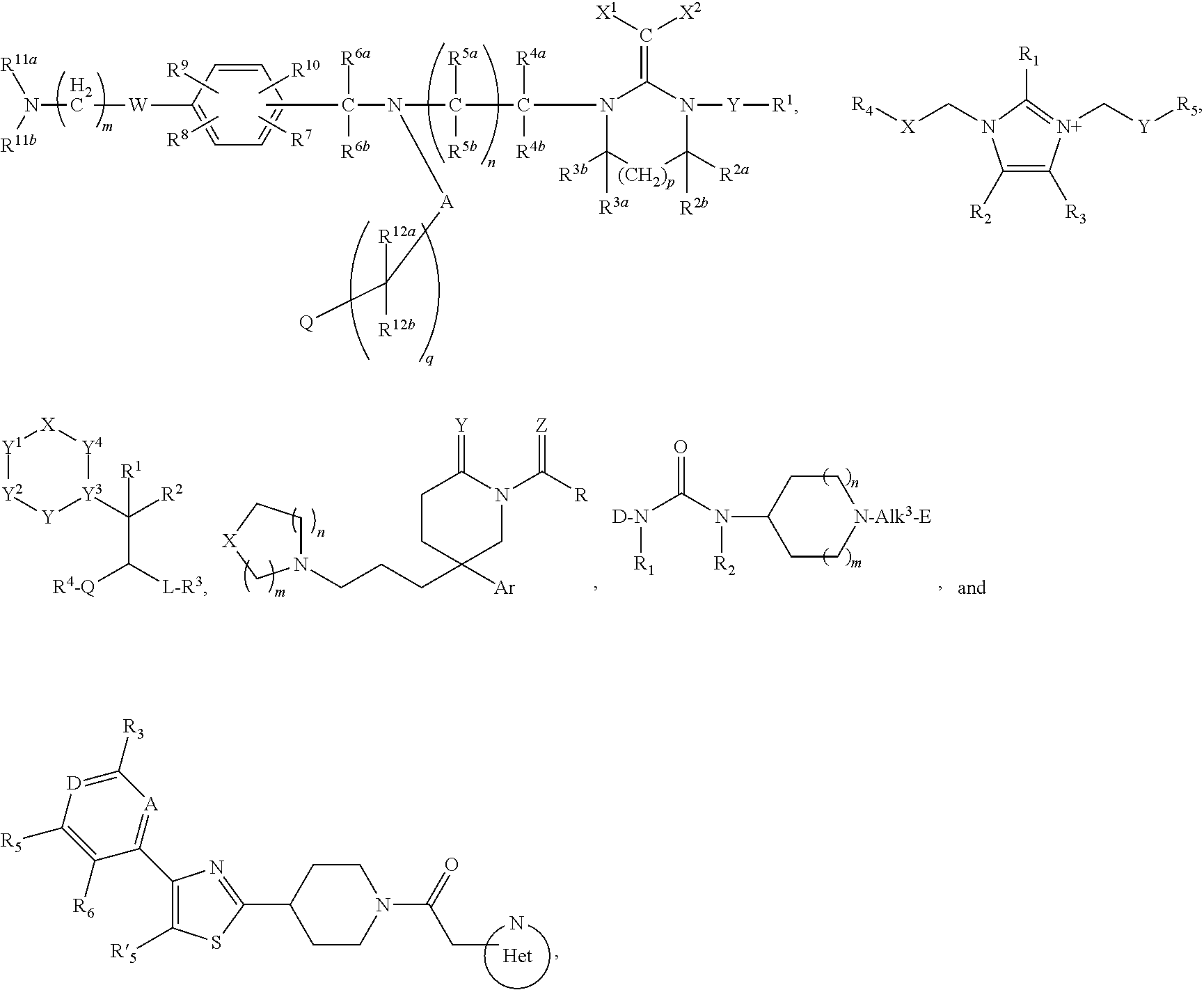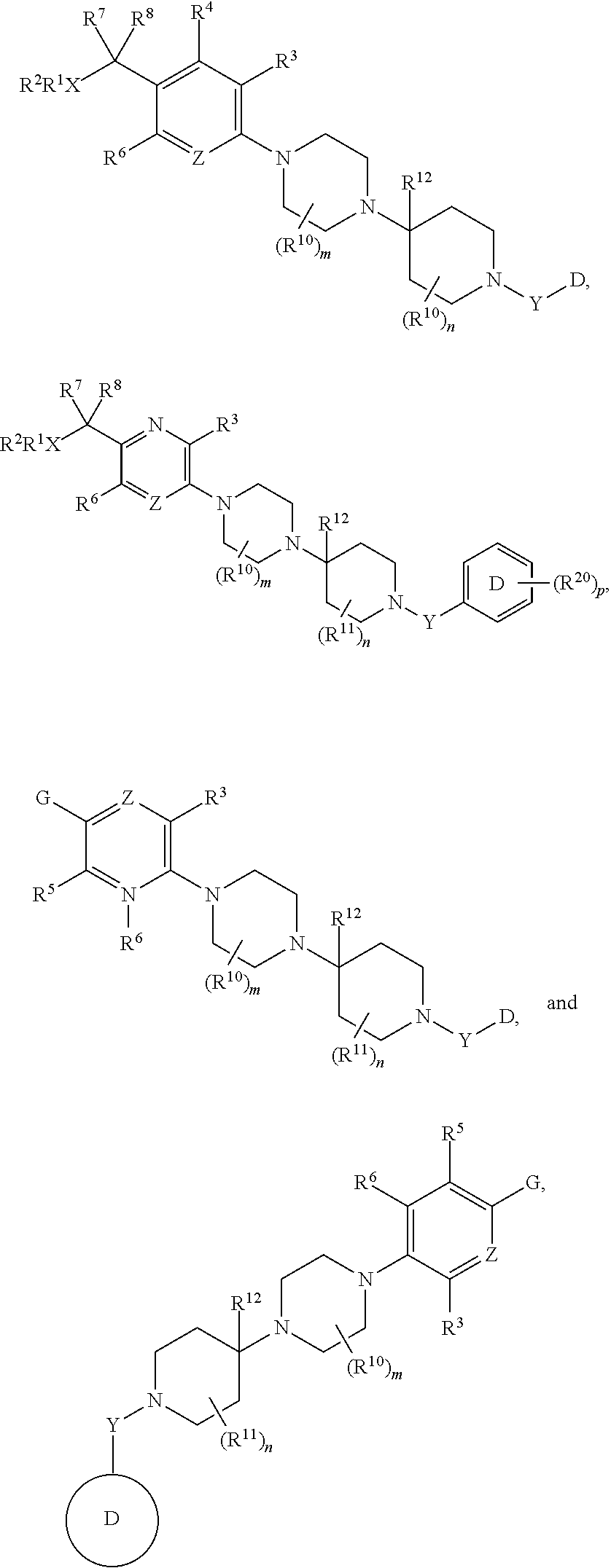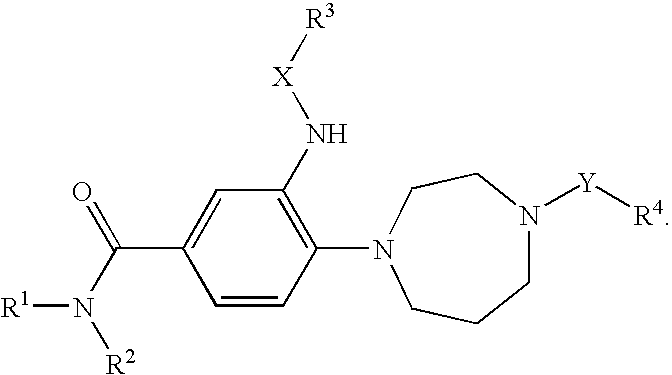Inhibitors of the chemokine receptor CxCR3
a technology of chemokine receptor and inhibitor, which is applied in the field of 3(amido or sulphamido)4(4substitutedazinyl) benzamide compound, can solve the problems of terminal morbidity and mortality, increased incidence of chemokine receptor, and significant energy and nutritional requirements for healing
- Summary
- Abstract
- Description
- Claims
- Application Information
AI Technical Summary
Benefits of technology
Problems solved by technology
Method used
Image
Examples
embodiments
[0136]With reference to inventions described herein, below are particular embodiments related thereto.
[0137]A particular embodiment according to the invention is wherein R1 is optionally substituted phenyl(C1-3 alkyl) or optionally substituted phenylcyclopropyl.
[0138]Another particular embodiment according to the invention is wherein R1 is optionally substituted phenyl(C1-3 alkyl).
[0139]Another particular embodiment according to the invention is wherein R1 is optionally substituted phenyl(C2-3 alkyl).
[0140]Another particular embodiment according to the invention is wherein R1 is optionally substituted phenyl(ethyl).
[0141]Another particular embodiment according to the invention is wherein R1 is phenylethyl.
[0142]Another particular embodiment according to the invention is wherein R1 is optionally substituted phenylcyclopropyl.
[0143]Another particular embodiment according to the invention is wherein the optionally substituted phenyl in R1 is substituted by halo.
[0144]Another particular...
example 1
[0234]Solution Phase Precursor Preparations
[0235]
[0236]Step 1: 3.7 g of 4-fluoro-3-nitro benzoic acid is treated with 1 M solution of 4-(dimethylaminoethyl)-piperazine in DMF for 120 min at 100° C. The reaction mixture is first checked by LCMS, then partially evaporated and crystallized from AN. Pure product (3 g) is obtained.
[0237]
[0238]Step 2: 322 mg (1 mmol) of product from the previous reaction is dissolved in 5 ml of DMF, together with 139 mg (1.1 mmol) of DIC and 459 mg (=3 mmol) of HOBt and 171 mg (1.1 mmol) of 4-chloro-phenethyl amine. After 2 h at ambient temperature ⅔ of solvent is evaporated, and oily residue is purified via several injections using Waters mass-triggered-LCMS purification system. Proper fractions are lyophilized to yield of 115 mg of desired material.
[0239]Step 3: 100 mg of the product from the previous reaction is dissolved in 8 mL of methanol and 100 mg of 5% Pd / C added. After evacuation in a Parr apparatus, 35 psi of hydrogen is introduced. The reactio...
example 2
N-{5-[2-(4-Chloro-phenyl)-ethylcarbamoyl]-2-[4-(2-dimethylamino-ethyl)-piperazin-1-yl]-phenyl}-isonicotinamide
[0246]
[0247]Starting from intermediate 2 HATU mediated coupling where 22 mg (0.05 mmol) of starting material, 0.15 mmol (57 mg) of HATU, 0.15 mmol (19 mg) of isonicotinic acid, and 0.3 mmol (39 mg=44 μL) of DIEA at ambient temperature is reacted for 3 h. LCMS check shows desired product, which is isolated after partial evaporation via Waters mass-triggered-LCMS purification system. Lyophilization yields desired product. MW=534.25 Da (calc. monoisotopic for C29H35ClN6O2), measured (M+H)+=535.3 Da with appropriate Cl-isotope pattern, UV {220} based purity 83.7%.
PUM
 Login to View More
Login to View More Abstract
Description
Claims
Application Information
 Login to View More
Login to View More - R&D
- Intellectual Property
- Life Sciences
- Materials
- Tech Scout
- Unparalleled Data Quality
- Higher Quality Content
- 60% Fewer Hallucinations
Browse by: Latest US Patents, China's latest patents, Technical Efficacy Thesaurus, Application Domain, Technology Topic, Popular Technical Reports.
© 2025 PatSnap. All rights reserved.Legal|Privacy policy|Modern Slavery Act Transparency Statement|Sitemap|About US| Contact US: help@patsnap.com



